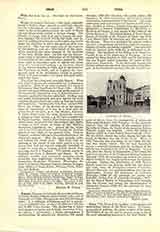

Crypt (or LOWER CHURCH).—The word originally meant a hidden place, natural or artificial, suitable for the concealment of persons or things. When visits to the burial-places without the walls of Rome fell into disuse there ensued a curious change. The Church, no longer able to go out to honor the martyrs, brought the martyrs within the walls, and instead of building churches above the tombs, dug tombs under the churches in which the precious relics were deposited. This was the origin, first of the confessio of the basilicas, and, at a later period, of the crypt, which answered the same purpose in the churches of the early Middle Ages. In this way the Romanesque crypt is the direct descendant of the hypogceum or excavation of the early Christian catacomb. The term crypt is sometimes used to signify the lower story of a two-storied building, e.g. the lower chapel of the Sainte-Chapelle at Paris, and of the church of San Francesco at Assisi; and in England the over-ground crypt of St. Ethelreda’s Chapel in London, which is all that remains of the great episcopal palace called Ely Place.
The crypt has a long and venerable history. What was done at Rome set a precedent for Christendom in general. There is an early example of a crypt at Ravenna, at Sant’ Apollinare in Clacse (534). At first crypts were sometimes as deep-sunk as the cubicula of the catacombs themselves, e.g. in Saint-Germain, at Auxerre, and in the Chartres cathedral. Or they were but partly above ground, and were lighted by small windows placed in their side walls, e.g. Ernulph’s crypt at Canterbury. Occasionally their floor was but little below the surface of the ground, as in the eastern crypt at Canterbury; or it was on a level with the pavement of the nave, as in San Miniato, Florence. In these latter cases the crypt practically became a second or lower church, e.g. St. Faith‘s, under Old St. Paul’s, London. Such a crypt, however, entailed a raised choir; hence it is that one ascends high flights of steps to such choirs as those of San Miniato, Rochester, Canterbury, etc. Almost all the crypts now found in England were built during the Norman period, or very early, in the pointed style. That at Glasgow, however, belongs to the perfected style of the thirteenth century. Here the crypt extends under and beyond the whole choir. Had there been an opening in the center of the vault (and it is by no means clear that one was not originally intended), it would be more like a German double church than anything found in England. The earliest crypts in England are those of Hexham and Ripon. In the eleventh, twelfth, and thirteenth centuries crypts developed into magnificent churches, like those of Gloucester, Rochester, Worcester, Winchester, St. Peter’s at Oxford, Bayeux, Chartres, Saintes, Bourges, Holy, Trinity at Caen, Padua, Florence, Pavia, Palermo, and Modena.

